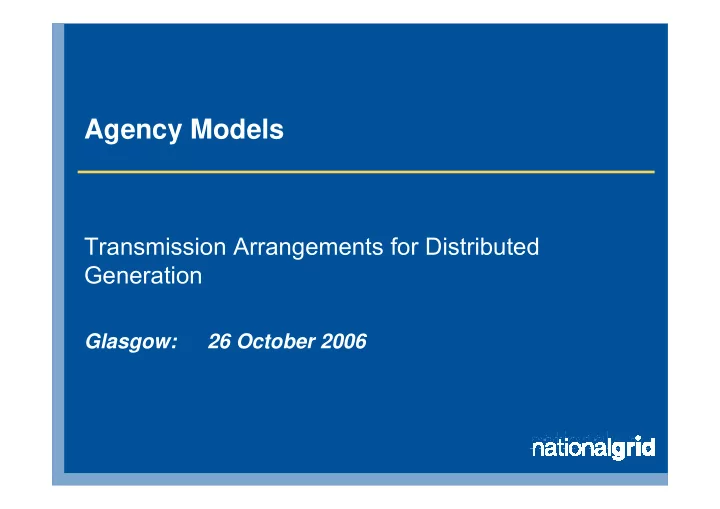

Agency Models Transmission Arrangements for Distributed Generation Glasgow: 26 October 2006
Structure � Review Agency Model Options � Focus on Gross Nodal Supplier Agency Model � Review issues raised � For NGET � Issues raised in TADG meetings � How the GNSAM addresses these issues
What do we mean by “Agency”? � ‘ business or service authorised to act for others ‘ � Single point of contact / interface � Aggregator of capacity and energy � Controller of despatch � Who? Options: � DNOs– DNO Agency � Supplier interface – Supplier Agency � The current model is an agent model
Flavours of agency � Gross vs. Net � “Gross” for most cost reflective charging of transmission costs � Nodal vs. Zonal � Operational requirement is nodal � GNSAM - Charging arrangements is a zonal tariffs, but nodal charge � DNO vs. Supplier � Supplier least change commercially � An operational interface with the DNO
Agency Model Matrix Gross of Gross of Net of Net of GSP GSP Group GSP GSP Group Very Difficult, SVA at GSP “TODAY” Group level, Supplier Agency GNSAM (sort of) Would need to Re-register 23m meters “Interconnector model” DNO Agency Possible, but involves a lot of change
Gross Nodal Supplier Agency Model (GNSAM) Today Demand Generation HHg1 EG Netted off M 1 Generation For a ∑ HHd - ∑ HHg + ∑ NHHd GSP BMU Supplier, HHd1 D HH £/kW NHH p/kWh £/kW Zonal Zonal Gen TNUoS NHHd1 GSP Dem Tariff Dem Tariff Tariff GROUP TEC TEC Generation HHg2 GNSAM EG BMU ∑ HHd + ∑ NHHd M 2 HHg1 HHg2 GSP + + HHg2 HH £/kW NHH p/kWh £/kW £/kW £/kW D Zonal Gen TNUoS Zonal Gen TNUoS Gen TNUoS Dem Tariff Tariff Dem Tariff Tariff Tariff NHHd2 Transmission Distribution Each embedded generator above a given threshold Network Network might be offered to the SO as a single BMU
GSNAM with consolidation Demand GSP HHg1 GROUP EG ∑ HHd + ∑ NHHd M 1 GSP HHd1 HH £/kW D NHH p/kWh Zonal NHHd1 Zonal Dem Tariff Dem Tariff HHg3 EG Generation HHg2 EG TEC TEC M 2 Generation GSP BMU NHHd2 HHg2 HHg4 HHg3 HHg1 D HHg2 + + £/kW £/kW £/kW HHg1 EG Gen TNUoS Gen TNUoS Gen TNUoS Tariff Tariff Tariff Transmission Distribution Network Network
NGET issues (1) � Investment planning � All generation impacts on transmission � Investment is driven by change � No access product - clarity required � Queue avoidance � Locational signals � Current signal perceived as not cost reflective � Strong incentive to embed � Size of ‘benefit’ is largely arbitrary � Position forecast to worsen
NGET issues (2) � Operational � Nodal control required � Access to services � Specific issues in Scotland � Nature of transmission � Small generators discount, C13 � Efficient Interface � Minimise interfaces where ever practicable
Industry issues (1) � Why do we need to change? � Cost benefit required for any change � Scope of change � Impact on new and existing parties � Interaction with Distribution Arrangements � Subjectivity of a de-minimis level � Over burdensome relationship with GBSO � Requirement to be party to industry codes � Cap97 / LEEMPS
Industry issues (2) � Clarification of rights � Who should have them � Gross / net � TEC / DEC � Nature of agreement with NGET � BEGA / BELLA / BCA / DNO exit � Double accounting � GB queue � Embedded generation is it negative demand?
How an Agency model addresses the issues (1) � Firstly, need to accept a need for change change needs to be beneficial � There may need to be changes to other arrangements � � Different flavours address different issues NGET believes GNSAM is balanced approach � � An agency model provides the most efficient interface � Supplier agency model draws largely upon existing arrangements � Agency model allows a level of aggregation � Cost reflective transmission signals for all generation
How an Agency model addresses the issues (2) � Agency model can address de-minimis issue Nodal Net � Gross at lower level (HH) � � Codification of access rights and obligations � Clarifies GB queue arrangements
Summary � Many issues common � None of the agency models are simple � But they are ‘doable’ � NGET think “gross” and “nodal” are important � No preference which agent � Supplier least change - evolution � GNSAM addresses � the main NGET issues � many of the industry issues
Recommend
More recommend